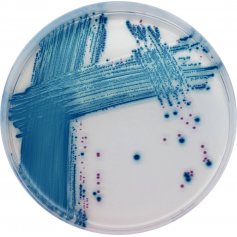Usability and Performance of CHROMagar™ STEC Medium in Detection of Shiga Toxin-Producing Escherichia coli Strains
08/2012
The performance and usability of CHROMagar STEC™ medium (CHROMagar Microbiology, Paris, France) for routine detection of Shiga toxin-producing Escherichia coli (STEC) strains were examined. The ability of the medium to selectively propagate STEC strains differing by their serotypes and virulence genes was studied with a collection of diarrheagenic E. coli isolates (n=365) consisting of 49 different serotypes and with non-STEC and other bacterial isolates (n=264). A total of 272 diarrheagenic E. coli (75.0%) isolates covering 24 different serotypes grew on CHROMagar™ STEC. The highest detection sensitivities were observed within the STEC serogroups O26 (90.0%), O111 (100.0%), O121 (100.0%), O145 (100.0%), and O157 (84.9%), and growth on CHROMagar™ STEC was highly associated with the presence of the tellurite resistance gene (terD). The specificity of the medium was 98.9%. In addition, CHROMagar™ STEC was used in parallel with a Shiga toxin-detecting immunoassay (Ridaquick Verotoxin/O157 Combi; R-biopharm, Darmstadt, Germany) to screen fecal specimens (n=47) collected from patients suffering
from hemorrhagic diarrhea. Positive growth on CHROMagar™ STEC was confirmed by the Premier EHEC enzyme immunoassay (Meridian Bioscience, Inc., Cincinnati, OH), and discrepant results between the two screening methods were confirmed by stx gene-detecting PCR. All 16 of the 47 stool samples that showed positive growth on CHROMagar™ STEC were also positive in the confirmatory tests. CHROMagar™ STEC proved to be an interesting option for STEC screening, allowing good detection sensitivity and specificity and permitting strain isolation for further outbreak investigations when required.
